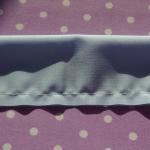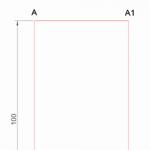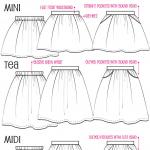Do-it-yourself knife of an unusual shape (O1 steel). Knife handle - interesting handmade design ideas (68 photos) Magnum Knife Set
Greetings to those who like to work with metal. This time we will look at how to make a knife of an unusual shape, it looks quite interesting. Such a knife can be taken with you when hunting, fishing or outdoors. Surely this product will not go unnoticed by your friends and acquaintances. It is not difficult to make such a knife, the manufacturing time will depend on the materials and tools you have. In general, there is nothing difficult in manufacturing, and even a master with an entry level will cope with the task.
The author used the O1 grade as steel. This steel is quite common among many foreign craftsmen. This steel contains almost 1% carbon, which makes it quite hard after quenching. Steel is hardened quite easily, it can be done at home, while the hardness can be over 60 HRC. There is also chromium in the composition of this steel, it prevents corrosion. Other useful alloying additives include manganese (1.2%), silicon (0.75%), chromium (0.5%), vanadium (0.20%) and tungsten (0.5%). Today, a blank from a similar steel for making a knife can be ordered via the Internet. So, let's take a closer look at how to make such a knife!
Materials and tools used
List of materials:
- steel O1;
- insulating tape;
- material for overlays;
- epoxy adhesive;
- oil for wood.
Tool list:
- stationery knife, paper and pencil (to make a template);
- belt sander;
- drill or drilling machine;
- grinder;
- drill;
- gas burner or forging furnace for hardening;
- band saw (you can cut the lining and profile of the knife);
- sandpaper;
- tools for etching the pattern;
- marker.
Knife making process:
Step one. Making a template
First, let's make a template for our knife. To do this, the author takes paper and draws the profile of the knife by hand. If you have a problem with this, you can print the desired profile on a printer. And then the author cut out the template using a clerical knife. The resulting template is either glued to steel, or outlined with a marker.






Step two. Cut out the main profile
Well, then we start cutting, for this the author used a grinder. You can also work with a cut-off band saw. Cut out the complex parts in pieces. Having cut out the main profile, we drill a hole in the area of the handle using a crown. We also need to drill holes for the pins.
Once this is ready, we go through the contour with a grinder with a grinding disc to remove the remaining parts.







Step three. Finishing
Next, the author is processing the profile along the contour on a belt sander. Hard-to-reach places are conveniently handled with a drill with an abrasive paper attachment.
Once this is done, draw a center line along the blade. It will allow us to make symmetrical bevels on both sides. This can be done with a drill of the same diameter as the thickness of the workpiece. There is no need to sharpen the knife at this step, the blade thickness should not be less than 2 mm, otherwise alloying elements will burn out during hardening.



Step four. Hardening
For hardening, you will need a forging furnace or gas burner. We heat the steel red-hot and dip it into the oil. Then we check if the hardening was successful using a file. If no metal is taken, quenching was successful. If the metal is taken, we heat it to a brighter glow.
Handle the metal with care afterwards, it will be brittle. This problem can be solved by tempering steel. As a result, we will get elasticity, the knife will spring under load. For these purposes, we use a household oven and temperature conditions for the selected steel grade. The knife should be left to cool with the oven for smooth cooling.



Step five. Cleaning, sanding and sharpening
After quenching, the metal will be black or straw-colored if you cleaned it before tempering. This is the result of metal oxidation. We clamp the blade on the table with a clamp and start grinding. We need sandpaper, the plaque is peeled off quite effectively. We moisten the sandpaper in water, so it is cleared of dirt.





Next, we proceed to finalizing the blade. First, we work on a belt sander, sharpen the blade to the maximum possible value. If you have a fine sanding belt or polishing belt, then you can sharpen the knife to perfect condition with it. The author used a special sharpening machine with a slowly rotating sharpening stone. Thanks to low rpms and water, the blade does not overheat and sharpens perfectly. Ideally, the blade should be such that it cuts the canopy paper. For further work, we wrap the blade with paper and tape on top so as not to cut ourselves.
Step six. Cut out the overlays
What material the author made of the overlays remains unknown, but this is clearly not a tree. The advantage of artificial materials over wood is that they are not afraid of moisture, the aggressive effects of salts, acids, the sun, and so on. We cut out two identical blanks, the author used a band cutting machine for this, but you can also handle it with a grinder. We bring the resulting blanks to almost end result using a belt sander.




Step seven. Assembling the handle
The handle is assembled in a proven way - using epoxy glue and pins. As for the pins, you can be smart and do something interesting. We carefully clean and degrease the surfaces to be glued. It is advisable to grind the metal with coarse sandpaper, the glue does not adhere well to a smooth surface.
We tighten the handle with clamps so that it sticks evenly along the entire length. We leave the glue to dry, it usually takes a day. After that, you can safely work with the product.








The glue is dry, now we go to the belt sander and shape the handle to the desired shape. For finer processing, the author used a drill with an abrasive paper attachment. Finishing is done by hand using a piece of fine sandpaper. If the pads are not made of wood, the sandpaper can be moistened with water and will work better this way. As a result, the handle can be polished.
Step eight. Etching pattern
A unique pattern can be applied to the knife, so it will look much more interesting. For etching, you need to make a stencil. The author made it from masking tape, and the drawing, in this case a letter, was burned out with a laser. To do this, tape is glued to the tree.
Well, then we proceed to etching. Typically, a saline solution and a power supply are used for this. We apply the plus to the product, and to the minus we connect a cotton wool soaked in salt water, and drive it to the place of etching. After a while, the exposed metal will "burn out" and we will get a durable drawing. That's all, after that we remove the tape and clean the knife from the glue.
A knife is an incredibly practical and useful thing, capable of being useful in the most different situations... But it seems that the designers and constructors who create all sorts of modifications of this tool do not always proceed from considerations of rationality, comfort and usefulness. In today's review, if not the most practical, then at least the most unusual knives were collected.
1. Scissor knife

The first thing that naturally catches your eye is, of course, the shape of any knife. Some of them are more than unusual and creative; in the desire of designers, they will stand out for their "creativity". For example, here is a curious knife made of black steel in the shape of one of the scissor blades.
2. Manticuda knife

This knife is marketed as a survival knife. It is assumed that Manticuda allows you to cope with the solution of a much larger list of tasks than any other knife of the "traditional" shape. Whether this is so in practice is a complex and controversial question.
3. Neolithic knife

The knife was one of the first man-made tools of labor. So a group of designers was inspired by the tools of labor from the times of the Neolithic revolution and created such an unusual knife. It is probably not worth saying that holding it with your hands is not very convenient and not very safe.

Some designers manage to combine things so different in their creations that it is even difficult to believe in their existence. Here, a knife-belt, for example, can claim the title of an amazing spy accessory in exactly the same measure as it can claim to be the most useless knife in everyday life.
5. Handle knife

Another variant of the "spy" knife is a handle knife. Under the graceful body ballpoint pen hides the blade of a knife. Speaking of the pen, he also writes, despite the fact that it has a lot less ink supply than any other.
6. Shark knife

Sharks are dangerous predators with many teeth. It is thanks to them (as well as the incredible strength of the jaws) that sharks are able to kill almost any living organism caught in the water. So the creators of this rather ridiculous glove knife were clearly inspired by sharks and their deadly jaws.
7. Lipstick knife

The knife is an incredibly popular tool with fans of hidden accessories. An interesting solution is this knife, which is hidden in women's lipstick. The interesting and entertaining idea is offset by the almost useless length of the blade.

A kitchen knife made from whole piece become. The only thing that is really remarkable is its design. Looks crimson with blood. You can play a trick with such a knife. Probably.

Finally, to the readers' attention, another knife for the masters of conspiracy and covert infiltration operations into their own home. A funny penknife with a handle that looks like a key to a door.
Different peoples used different shapes knives. Some were created to kill animals, others to harvest. Modern designers are experimenting not only with the shape of the blade, but also with the design of the handles of products.
The most dangerous knives
Among the considerable species diversity of knives, one can single out those that are considered the most dangerous. Next - about the most dangerous knives.Brass knuckles
The brass knuckles are a kind of the ancient knife - katar. The peak of popularity of the knuckle-duster knife fell on the days of the gold rush. It was especially often used in a criminal environment. The blade of the brass knuckles is attached to the handle perpendicularly. It is worn on the belt or hidden in the sleeve. 
"Butterfly" or balisong
One of the most dangerous knives is the butterfly knife. It has many names - "Batangas knife", "click-click", "barangay", "ventnovi" and balisong. Its handle is divided in length into two halves, when thrown away, a blade appears. Such a knife fit into several systems of martial arts. The popularity of this edged weapon fell on the second half of the last century. Of the folding knives, it is the balisong that is the most reliable and fastest. The downside of this knife is that you need to learn how to handle it. 
Stylet
A stiletto is a dagger with a three or four sided blade, which is designed for stabbing blows. The stylet was invented in Italy in the sixteenth century. V classic performance the stilettos are devoid of a cutting edge. This weapon was worn secretly during the Renaissance, which was possible due to its small size. 
Knives with original designs
The design idea does not stand still. It would seem that there are so many unusual knives that it is already impossible to come up with something extraordinary. However, it is not. Further about the most original knives.Safety knife
The so-called safety knife is unusual. It cannot be used as a weapon. It is convenient to use it for cooking, but its tip is rounded, which means that no one will get hurt by it. The inventor is John Kornok. 
Lipstick knife
In a purse or cosmetic bag lipstick- the knife is quite in place. It is small in size. The stainless steel blade is only three centimeters long. The total length of this accessory is only seven and a half centimeters. 
Sapphire knife
A knife made without the use of metal is unusual. It's about a sapphire knife. Its handle is made of bone, and the blade is made of artificial sapphire. V last years such knives have become popular among weapon lovers. 
"Pearl of the East"
Two million one hundred thousand dollars - this is the cost of a unique knife with the beautiful name "Pearl of the East". It was made by one of the most famous knife designers, Buster Warenski. He worked on this piece of art for almost ten years. The knife is decorated with gold and precious stones. 
Key knife
A knife made in the form of a key can also hang on the bunch of keys. This German knife is slightly larger than a regular key. Nevertheless, in an unforeseen situation, he can help out the owner. 
Turkana's finger knife
The knife, which was put on the finger, was used by the Turkana tribe. Outwardly, it looks like a ring with an eight-centimeter protruding plate. It was made from aluminum and iron. Such weapons were used not only in battle, trying to damage the eyes of the enemy, but also in everyday life when cooking, and even as a toothpick. 
The most unusual knife in the world
A knife with a hundred pieces is the most unusual in the world. It is located in the historic center of Buffalo Bill in America in Wyoming. Knife parts can be used in a variety of life situations, they are designed for different purposes. One of the details is a twenty-second caliber revolver. 
This knife is neither comfortable nor functional. It is twenty-two centimeters long and nine centimeters wide. This exhibition copy was made to order. There is no second such. Its purpose is to showcase the capabilities and talents of Holler's craftsmen. The cost of unusual designer knives is comparable to the price jewelry... On the Uznayvse website there is about the most expensive jewelry.
Subscribe to our channel in Yandex.Zen
Previously, kitchen knives were just tools for preparing food. Sharpness and ease of use were appreciated in them. Appearance did not play a special role. Today, making kitchen knives is a whole art. The knife is a complete part of the kitchen interior.
Knives that are easy to store
These nesting hollow-core knives make storage very easy for their owners. Moreover, they have sharp blades and comfortable handles.
Knives from France's TB Groupe
These elegant black knives feature laser cut handles and extremely sharp stainless steel blades. The blades require sharpening only once every 25 years.
Price - $ 78 (for one)
These knives are similar to the previous ones, but they are somewhat more affordable.

Price - $ 120 (for a set of three knives
The starry sky in the hands
This set features a neat pattern that adds to the attractiveness of the knives. Available in blue, white and red.

Set with stand
Another set in black. Sold with a stand.

Steel chrome knives
These chrome-plated knives from F. A. Porsche are made from AISI 301 chrome-nickel steel. The sleek design of all units is designed for ease of use.
Price - $ 124 (for one)
Cutting with high precision and accuracy
You will achieve perfection in the art of slicing food with ultra-thin and comfortable knives from designer Henri Mazelier.
Knife by designer Henri Mazelier
An explosion of color in your kitchen!
Bring a little flair to the daily routine of cooking! A bright and catchy set of knives from Kai consists of 8 units.

Rainbow in your kitchen
This set is even more rosy and costs significantly less.

Another option for knives with a stand
Another multi-colored combination that includes a magnetic knife board.

Wonderful patterns
Shchegolsky, a chic set of knives with patterns!

Inspirational knives
Stylish and awesome
A little bit of quirk doesn't hurt the kitchen, and this set of knives can bring it in!

Unusual stand design
Minimum details
The Concavo knife set consists of 8 units that are both functional and attractive.

For true samurai
Treat your inner samurai with a set of 4 knives (stand included)!

Simple wood grain design
This design combines the cutting power of steel and wood grain style.

A little humor
Fun option: Finish the slicing and let off some steam with the Former set of 5 knives.

Minimalism in design
The minimalist knife set combines clean design with high aesthetics.

Ceramic set
This jet black ceramic set looks amazing and is a pleasure to use!

Japanese knives
The indentations in the blades of these Japanese steel knives keep food from sticking while slicing.

Metal knives with a wooden stand
You will get great quality and stylish looks with knives from West Elm.

Unrivaled balance
The amazing balance that the knives from this set demonstrate, underline their high "performance".
Courtesy of Matrix Imports
Consonance between price and quality
While not the cheapest option, this set of Japanese knives is sure to be the prettiest.

Unique Japan, price - $ 1199
Cheese knives
A true piece of design art, these gorgeous cheese slicers will be a hit at any party.
Source: Scandium
An incredibly attractive knife from Eric Bertes
This perfectly balanced version is a true piece of design art.

Designer - Eric Bertes
Knife with transparent base
By placing this knife in a transparent minimalist stand, you can show its beauty even when you are not using it.
Designer - Taras Kravchuk
Incredibly shaped designer knife
This kitchen knife is just a design project so far, but how beautiful it is!
Designer - Andre Marsigila
Creative Handle Knives
Another project created by designer Neil Davidson. The intricate handles look great!
Designer - Neil Davidson
Wooden knives
Handcrafted in Japan, these wooden knives exhibit amazing craftsmanship.
Designer - Andrea Ponti
Multifunction knives
The idea for this amazing concept originated in the belief that a truly great knife should be able to do more than just slicing.
(Photo translation: chemical etched grater; herb spatula, 6-inch kitchen knife; integrated peeler; 4-inch vegetable peeler; integrated peel / garnish blade)
Another utility knife
Another knife made for F.O.R. allows you to not only cut neatly, but also to scoop and collect the sliced food.

Designer - Mikhail Belyaev
Rounded handle version
It is also more suitable for scooping and collecting food. The rounded handle is not very convenient for long cutting a large number products.
Designer - Johanna Gauderfest
Another option for hollow knives
The hollow blade knife and similar forks were conceived by designer Jeff Pinard.
Designer - Jeff Pinard
Inspiration from ancient ancestors
The design of these knives is inspired by the Neolithic period. He reinforces the idea that work can become much more efficient if you step back from the present and return to the ideas of the past.

Designer - Mathias Kading
Robert Larsson project
Its minimalist idea is embodied in the form of tools with a convex outline and a contrasting handle.

Designer - Robert Larsson
Knife stand with lock
The legend of King Arthur's sword, buried in stone, inspired the creators to design a similar stand. She will not let the knives fall into the clumsy hands of children.

Designer - Jolanda Firs
Stand with lock and sterilizer
This stand demonstrates another way to store knives, which allows you not only to lock them, but also to sterilize them.
Designer: Min Seong Kim
Detailing of functions:
- knife lock - the knife will be securely locked by turning it 270 ° to the left
- image
- ultraviolet rays - when the knife is blocked, the LED-backlight of the display turns on, and the knives are sterilized inside the device at this time
Natural elements in design
Handcrafted at the Mermelada Studio, these knives are inspired by the shapes and singing of birds.
Bird shaped knives
Magnum Knife Set
It impresses with its bright colors and originality of design.

Price - $ 169 per set
Childproof knives
The stand with self-closing knife slots also has a stylish design.

Spooky but stylish
These knives may not be the most convenient option, but they undoubtedly have surprising and eerie appeal.

Skeleton Handled Knives
The knives are the necessary tools for cooking food. They can be stylish and expensive, or modest, but very comfortable. If you need to create a single and unique design in the kitchen, kitchen knives can be an excellent interior detail.





